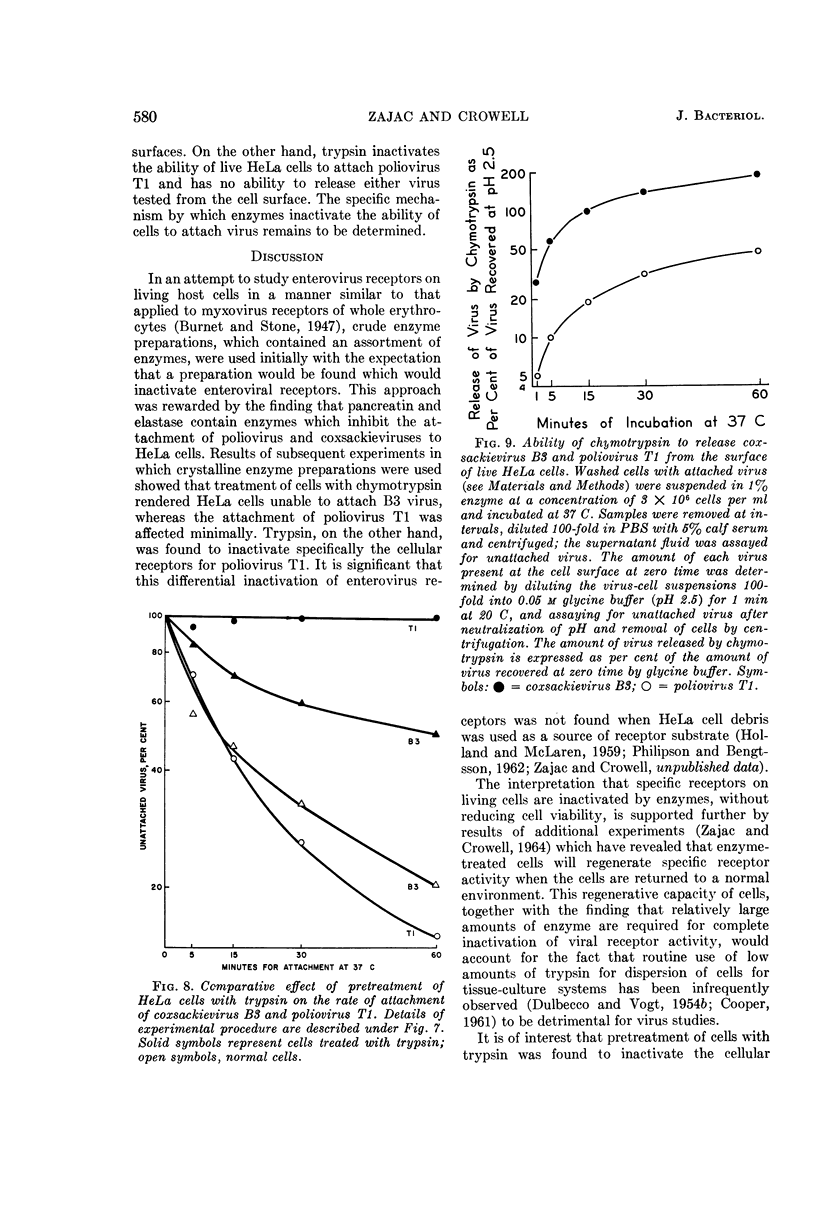Abstract
Zajac, Ihor (Hahnemann Medical College, Philadelphia, Pa.), and Richard L. Crowell. Effect of enzymes on the interaction of enteroviruses with living HeLa cells. J. Bacteriol. 89:574–582. 1965.—Eight crude enzyme preparations and two crystalline enzymes were tested for ability to inactivate coxsackie group B and poliovirus receptors on living HeLa cells. Receptor-destroying enzyme, erepsin, lysozyme, collagenase, proteinase, and cobra venom did not alter attachment of coxsackie B3 or poliovirus T1 to cells, whereas elastase prevented attachment of both viruses tested. Treatment of live cells with pancreatin or chymotrypsin rendered cells unable to attach group B coxsackie viruses, whereas cells treated with trypsin failed to attach poliovirus T1. In addition, chymotrypsin was found to release coxsackie B3 and poliovirus T1 from cell surfaces, whereas trypsin was unable to dissociate virus-cell union. These results indicate that cellular receptors for polioviruses differ from those for group B coxsackie-viruses. The finding that 1% solutions of enzymes will inactivate differentially the enteroviral receptors of HeLa cells, without altering cell viability, provides a useful approach for study of enterovirus receptors of live host cells.
Full text
PDF








Selected References
These references are in PubMed. This may not be the complete list of references from this article.
- COOK G. M., HEARD D. H., SEAMAN G. V. A sialomucopeptide liberated by trypsin from the human erythrocyte. Nature. 1960 Dec 17;188:1011–1012. doi: 10.1038/1881011a0. [DOI] [PubMed] [Google Scholar]
- COOPER P. D. The plaque assay of animal viruses. Adv Virus Res. 1961;8:319–378. doi: 10.1016/s0065-3527(08)60689-2. [DOI] [PubMed] [Google Scholar]
- CROWELL R. L. SPECIFIC VIRAL INTERFERENCE IN HELA CELL CULTURES CHRONICALLY INFECTED WITH COXSACKIE B5 VIRUS. J Bacteriol. 1963 Sep;86:517–526. doi: 10.1128/jb.86.3.517-526.1963. [DOI] [PMC free article] [PubMed] [Google Scholar]
- CROWELL R. L., SYVERTON J. T. The mammalian cell-virus relationship. VI. Sustained infection of HeLa cells by Coxsackie B3 virus and effect on superinfection. J Exp Med. 1961 Feb 1;113:419–435. doi: 10.1084/jem.113.2.419. [DOI] [PMC free article] [PubMed] [Google Scholar]
- DULBECCO R., VOGT M. One-step growth curve of Western equine encephalomyelitis virus on chicken embryo cells grown in vitro and analysis of virus yields from single cells. J Exp Med. 1954 Feb;99(2):183–199. doi: 10.1084/jem.99.2.183. [DOI] [PMC free article] [PubMed] [Google Scholar]
- DULBECCO R., VOGT M. Plaque formation and isolation of pure lines with poliomyelitis viruses. J Exp Med. 1954 Feb;99(2):167–182. doi: 10.1084/jem.99.2.167. [DOI] [PMC free article] [PubMed] [Google Scholar]
- EASTY G. C., EASTY D. M., AMBROSE E. J. Studies of cellular adhesiveness. Exp Cell Res. 1960 Apr;19:539–548. doi: 10.1016/0014-4827(60)90062-8. [DOI] [PubMed] [Google Scholar]
- FENWICK M. L., COOPER P. D. Early interactions between poliovirus and ERK cells: some observations on the nature and significance of the rejected particles. Virology. 1962 Oct;18:212–223. doi: 10.1016/0042-6822(62)90007-7. [DOI] [PubMed] [Google Scholar]
- HOLLAND J. J. Irreversible eclipse of poliovirus by HeLa cells. Virology. 1962 Feb;16:163–176. doi: 10.1016/0042-6822(62)90292-1. [DOI] [PubMed] [Google Scholar]
- HOLLAND J. J., McLAREN L. C. The mammalian cell-virus relationship. II. Adsorption, reception, and eclipse of poliovirus by HeLa cells. J Exp Med. 1959 May 1;109(5):487–504. doi: 10.1084/jem.109.5.487. [DOI] [PMC free article] [PubMed] [Google Scholar]
- MARCUS P. I. Dynamics of surface modification in myxovirus-infected cells. Cold Spring Harb Symp Quant Biol. 1962;27:351–365. doi: 10.1101/sqb.1962.027.001.033. [DOI] [PubMed] [Google Scholar]
- PONDER E. Effects produced by trypsin on certain properties of the human red cell. Blood. 1951 Apr;6(4):350–356. [PubMed] [Google Scholar]
- PUCK T. T., MARCUS P. I., CIECIURA S. J. Clonal growth of mammalian cells in vitro; growth characteristics of colonies from single HeLa cells with and without a feeder layer. J Exp Med. 1956 Feb 1;103(2):273–283. doi: 10.1084/jem.103.2.273. [DOI] [PMC free article] [PubMed] [Google Scholar]
- SCHOELLMANN G., SHAW E. Direct evidence for the presence of histidine in the active center of chymotrypsin. Biochemistry. 1963 Mar-Apr;2:252–255. doi: 10.1021/bi00902a008. [DOI] [PubMed] [Google Scholar]
- SPRINGER G. F. Enzymatic and nonezymatic alterations of erythrocyte surface antigens. Bacteriol Rev. 1963 Jun;27:191–227. doi: 10.1128/br.27.2.191-227.1963. [DOI] [PMC free article] [PubMed] [Google Scholar]
- THORNE H. V. ELECTROPHORETIC STUDY OF THE INTERACTION OF RADIOACTIVE POLIOVIRUS WITH COMPONENTS OF CULTURED CELLS. J Bacteriol. 1963 Jun;85:1247–1255. doi: 10.1128/jb.85.6.1247-1255.1963. [DOI] [PMC free article] [PubMed] [Google Scholar]
- WEISS L. Studies on cellular adhesion in tissue-culture. V. Some effects of enzymes on cell-detachment. Exp Cell Res. 1963 May;30:509–520. doi: 10.1016/0014-4827(63)90327-6. [DOI] [PubMed] [Google Scholar]
- WEISS L. The effects of trypsin on the size, viability and dry mass of sarcoma 37 cells. Exp Cell Res. 1958 Feb;14(1):80–83. doi: 10.1016/0014-4827(58)90214-3. [DOI] [PubMed] [Google Scholar]


